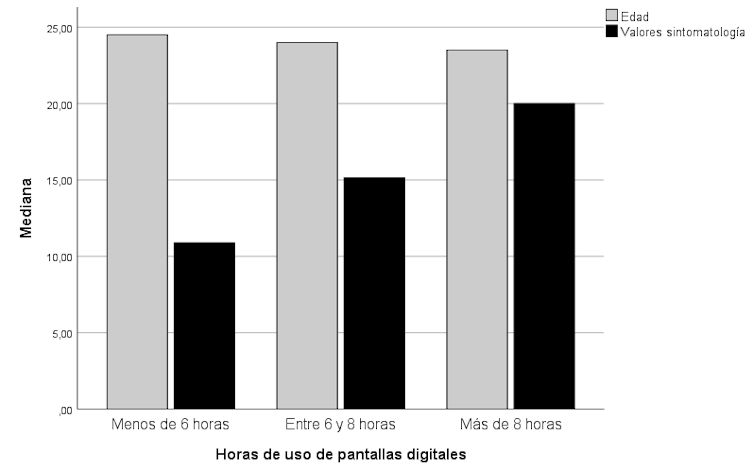Every day, more and more patients are seeking medical attention after spending long days in front of computer screens. The most common symptoms include irritated or itchy eyes, and a sensation of dryness or sand on the surface of the eye.
These are the tell tale signs of dry eye disease, which affects anywhere from 5% to 50% of the world’s population, depending on age, gender, ethnicity and other factors. This condition can stem from multiple causes, but lifestyle plays an important role. Screen use – and overuse – is one of the leading factors.
We blink less when looking at computers, phones and tablets, and when we do, our blinking is often incomplete, meaning the eye does not fully close. Screens are also a source of projected light, which raises the temperature of the eye’s surface and increases tear evaporation.
At the University of Santiago de Compostela, in Spain, we carried out a study of university students who received hybrid teaching during the COVID pandemic: 50% of their classes were in person, and 50% were online. According to the data we gathered, increased screen time was linked to more severe dry eye symptoms. Those who used screens for more time outside class (over 8 hours per day) showed more acute symptoms.

Although reducing screen time is impossible in certain jobs, we can reduce irritation and problems by following certain recommendations. A basic understanding of the issue can also help us to look after our eyes.
Teardrops and eyelids
The eye’s surface is made up of eyelids, the tear film (the eye’s liquid coating), the cornea and the conjunctiva. The health of these tissues is linked to the eye’s functioning. If any of them are affected, it can lead to irritation in the eye.
The tear film is made up of two layers. The bottom layer consists of proteins and water, and the top consists of oil. The water layer is responsible for keeping the eye hydrated, while the oil prevents it from evaporating too quickly. Problems with either layer can cause imbalances, preventing them from being distributed evenly and leading to irritation.
The eyelids are what keep the tear film evenly distributed, as well as providing protection. Blinking less often – which we do when looking at a screen – prevents this layer from being properly distributed over the eye’s surface.
Do you suffer from dry eye disease?
First and foremost, there is often no cause for panic: suffering certain symptoms of dry eyes does not necessarily mean you have dry eye disease. The guide published by the Tear Film & Ocular Surface Society makes it very clear that, in addition to reported symptoms, patients must also show signs of damage to the eye’s surface. A medical professional will determine whether this damage exists, and what further measures need to be taken.
There are, however, certain signs to watch out for. These include a sensation of dryness, itching, burning, irritation or watering eyes. Researchers have found that the most common symptom after extended screen use is irritation.
How to reduce irritation and avoid dry eye disease
By taking precautions, we can ensure that screens work with us, not against us.
- Screen height: It is always best to keep screens below eye level. This way the eyelids do not have to open as much, meaning less of the eye’s surface is exposed for prolonged periods.
- Screen position and lighting: You should avoid light reflecting off screens, be it from a lamp or from a window behind where you sit. Excessive light forces us to concentrate harder, and therefore to blink less. This can be solved by using anti reflective filters.
- Rest periods: Rest is your eyes’ best friend. A common rule of thumb is the 20-20-20 rule. For every 20 minutes of work, look at something 20 feet away (about 6 metres), for 20 seconds. This has been proven to reduce symptoms of eye dryness, as looking away from the screen re establishes our normal rate of blinking.
- Environmental conditions: Low humidity, high temperatures, air currents from open windows or air conditioners, tobacco smoke and excessive air freshener can all be bad for eye health.
- Eye hydration: Eye drops may be the best option on particularly intense working days. Avoid saline solutions, as their composition is not the same as the tear film. They lack the oils and proteins, and could destabilize this layer. The best option is single dose artificial tears, which do not contain preservatives and do not damage the eye.
The prevalence of screens in our society means that symptoms of dry eye disease are commonplace. If we confront this issue by taking the right steps, however, it doesn’t have to affect our quality of life.![]()
Jacobo García Queiruga, Profesor Interino en el Área de Optometría (OD, MSc, PhD), Universidade de Santiago de Compostela and Belen Sabucedo Villamarín, Investigador predoctoral en Medicina Molecular del GI-2092 en Optometría, Universidade de Santiago de Compostela, Universidade de Santiago de Compostela. This article is republished from The Conversation under a Creative Commons license. Read the original article.




